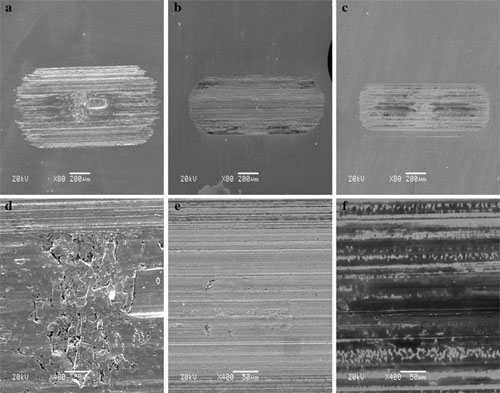With the remarkable development of the bearing and steel industries in terms of high applied loads, high temperature, and instantaneous overloaded conditions, new questions have been raised. Various lubricants are used for the lubrication of machine components operating under these lubrication conditions. Greases and additives are commonly used to provide the desirable properties and interaction with the interface. The development of more efficient boundary lubricants is a major focus of researchers in this field.
In view of this, researchers at the State Key Laboratory of Solid Lubrication, Lanzhou Institute of Chemical Physics (LICP), Chinese Academy of Sciences (CAS), have studied the tribological behaviors of different proportions of amorphous and crystalline calcium carbonates dispersed in calcium sulfonate in lithium complex grease.
 |
| Scanning electron microscopy micrographs of the worn surfaces on test disks: a, d base grease, b, e 8 wt% AOBCS, c, f 8 wt% COBCS |
They first transformed AOBCS into COBCS which is mainly composed of calcite. FTIR results elucidated the changes in the transformation of ACC into calcite. The effect of the transformation of calcium carbonate polymorphs on the tribological behavior of lithium complex grease was studied under different test methods and conditions. The transformation of calcium carbonate crystals, i.e., calcite, displayed excellent friction-reducing, AW, and EP properties based on the experimental results and subsequent discussions. The results also indicate that the ACC was partially transformed into calcite under increased applied loads, high temperature, contact pressure, and other extreme friction conditions. The XPS results showed that both the AOBCS and COBCS in base grease underwent complicated tribochemical reactions and that boundary tribofilms consisting of CaCO3, CaO, iron oxide, and organic compounds were formed on the rubbing surfaces.
The results of this study illustrate that the transformation of calcium carbonate polymorphs under extreme tribological conditions was the main factor involved in improving the tribological properties of grease. Therefore, the conversion of calcium carbonate polymorphs has a profound potential to broaden the application of AOBCS used as an AW/EP additive in the lubricating industry.
The work has received support from the National Program on Key Basic Research Project of China (973 Program). The findings have been published in Tribol Lett (Tribol Lett (2012) 45:265–273).


